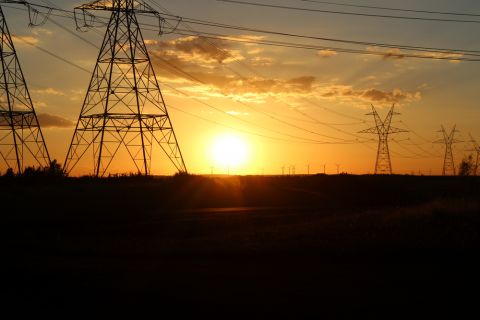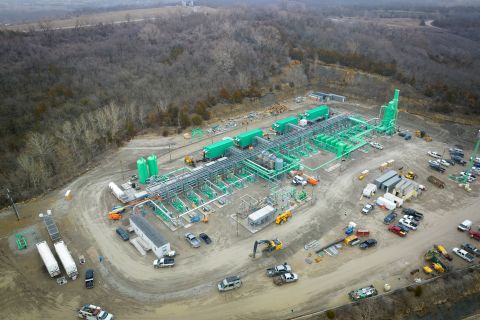James Cutler, executive vice president for Petral Worldwide Inc., reminisces about the history of midstream—from the routine operations of the 1960s to today’s amazing changes.
Although the midstream sector is now a large part of the oil and gas industry, it wasn’t that long ago that it was considered a bit of a nuisance to big oil companies.
The 1960s might have been the boom period for movies, rock n’ roll and advertising, but it would be another decade before the midstream really got its start. James Cutler, executive vice president for Petral Worldwide Inc., began his career around the same time the midstream was beginning to take shape.
“When I first started in the oil business, there was a very limited midstream business. The removal of NGLs [natural gas liquids] from natural gas was viewed to be a ‘garbage disposal’ activity. The major oil companies handled this activity themselves, and it was generally run as a cost center, not a profit center. If you found gas, you could almost get yourself fired. In those days the petrochemical industry was viewed as an extension of the refining industry,” he tells Midstream Monitor, Hart Energy’s weekly midstream newsletter.
Cutler was also ahead of the curve when it came to his educational background. He earned his B.S. in industrial engineering at Northeastern University and his MBA from the Amos Tuck School of Business at Dartmouth College. The mixture of engineering and finance was a precursor to the background of many midstream executives, particularly related to master limited partnerships (MLPs).
“I started work as a staff industrial engineer with Allied Chemical, but because of my MBA, I subsequently became a financial analyst. This was somewhat unusual because relatively few engineers held MBAs from an Ivy League school,” he says.
Having gained experience in the oil industry through Allied Chemical’s acquisition of Union Texas, Cutler was able to transition to Getty Oil. “When Allied moved its offices from the Wall Street area to Morristown, New Jersey, I decided to stay in New York City and went to work for Getty Oil as financial planning manager. The principal attraction for this move was that I lived on 70th Street, and the Getty offices were on 65th Street. It was the late 1960s, and I was single,” he says.
Cutler moved further into what is now the midstream business when Texaco acquired Getty Oil. After marrying several years later, he and his wife moved to Houston, where he had the overall responsibility of purchasing NGLs as feedstock and energy manager at Texaco Chemical. He noted that in order to evaluate new petrochemical development opportunities, you have to understand midstream operations since feedstock costs influence petrochemical economics far more than capital costs.
One of the interesting things that he noted when comparing today’s midstream industry to what it was like in the 1960s was that producers had little interest in natural gas and instead were focusing on crude oil in both cases. “They wanted to push the gas to market with a minimal amount of effort and aggravation,” he says.
When Cutler first entered the oil and gas industry, he says the best and brightest didn’t gravitate to the midstream sectors. “What we know as the midstream was often the place where ‘old-timers’ sat it out and waited for retirement.”
This started changing in the 1970s when the majors began to segment their activities into profit centers following the planning models developed by the consulting firms of McKinsey and Boston Consulting. This resulted in companies spinning off their midstream components and brought fresh investments into the spectrum, which improved operation efficiencies.
It was also around this time that the federal tax laws allowed for MLPs to invest in pipelines and other oil and gas-related infrastructure. “Along with the development of shale reserves, this tax incentive has contributed to the recent dynamism and profitability of midstream operations,” he says.
In 1992, Cutler was again ahead of the curve when it came to the midstream when he co-founded Petral Worldwide, a Houston- based consulting firm. “The current midstream business is much more efficient than it was 30 years ago. Midstream activities now attract some of the best and brightest. As far as midstream staffing is concerned, while the quality of the personnel is high, having smaller staffs makes in-depth training more difficult. This factor has been a boon to the consulting industry,” he says.
Imposing a Gulf Coast model in the Northeast
Cutler’s vast experience in the industry has given him a unique perspective on the industry and on some recent developments. One, in particular, is the push for a world-scale ethylene plant (capable of cracking approximately 2 billion pounds of ethane per year, which requires about 60,000 barrels per day of ethane feedstock) in the Northeast to crack ethane production out of the Appalachian basin.
“During the ’60s while we were expanding the chemical business, the thought process was to either build the plants near the end-use markets or close to where the feedstocks were going to be. Because the petrochemical industry was frequently integrated with refineries, the popular thought was to build petrochemical plants near refineries and where the feedstocks were,” he says.
As this thought prevailed, it led to the development of vast salt dome caverns unique to Mont Belvieu, which is connected to every market in North America and houses facilities large enough to handle all volumes from the hub.
“There were plants elsewhere, Clinton, Iowa, for example, but these were aberrations to the original concept of building big plants near refineries. We still seem to have the mentality that all units have to be world scale. Having crunched the numbers for many years, I think the numbers bear out that this concept, in many aspects, is a myth,” Cutler says.
He notes that there isn’t much of an economy of scale with ethylene plants, particularly those using ethane as a feedstock. What is often overlooked is that a start-up plant usually does not operate at full capacity and most plants run between 80% and 90% of capacity. “That last increment of capacity you’re not getting shouldn’t even be considered. Even if you filled up the plant, then you have to start stepping out to get additional volumes, and your netback is not the same. You also need to review what rolling stock it takes to move your material out as you’ll start to lose your economies of scale through transportation requirements,” he says.
Cutler suggests that with the push for an ethylene plant in the Northeast, the industry is superimposing a Gulf Coast model on the Appalachian basin.
“I don’t think we’re looking at true economic development. It’s like running around with a screwdriver and looking for loose screws. We’re trying to superimpose an old model in a brand new environment. The world has changed,” he says.
While world-scale plants make sense on the Gulf Coast, which has a spaghetti bowl of pipelines throughout, such a system is not in place in the Northeast, Cutler says. “We have a large concentration of petrochemical facilities in the Gulf Coast, and all of the plants are big. This is what most people in the midstream industry see every day.
“There is a wonderful interconnectivity that we see nowhere else in the world. We think that this is the way to do things everywhere, and we look at the tremendous opportunity in Appalachia. Rather than asking what is the best way to do things right now in that region, we work with the system we know.”
According to Cutler, a 500-million-pound plant can be economical and viable in the region. This size is still quite large, but it is also flexible and doesn’t require as much additional infrastructure.
“If you look at what you have to do with the development of storage and the peripheral projects associated with a worldscale plant, you are talking about billions of dollars of investment. But, with a 500-million-pound plant, you have the capability to integrate regional plants. While you don’t have the so-called economies of scale, you can have the plants feed off one another,” he says.
Another benefit of this smaller approach is that it provides more market stability as the market isn’t hammered when a facility goes down or an event such as a natural disaster occurs.
If the Northeast were dependent on a single world-scale cracker, it would be difficult to store ethane in the region when the plant is down for maintenance or due to an unforeseen event. However, this isn’t the case with a smaller plant, which can store volumes in above-ground tanks.
“If a facility were down longer term, 14,000 barrels (bbl.) per day from a smaller plant has a much easier way finding a home through pipelines than 60,000 bbl. per day from a worldscale plant,” he says.
Smaller-scale plants must come to market first
Despite the positives that such an approach would have, Cutler noted that if a world-scale cracker were to be built in the region, then it becomes very difficult to build a smaller plant.
“It would make it more difficult to find the financing for smaller plants. Venture capitalists look at a 20% rate of return with a 10-year payout. If Shell or someone else builds a worldscale plant, then the economics change. When you buy feedstocks, you don’t get a discount for volumes. It’s either the same price or you start bidding the price up. If you have a worldscale ethylene plant, the Enterprise pipeline moving ethane to Mont Belvieu and the Sunoco Logistics pipeline moving ethane to Sarnia, there would still be ample ethane, but you start to get to the ragged edge of supply.
“That triggers two concerns for potential financiers of smaller plants: one, how do you know you’ll get the necessary production volumes from natural gas because you can’t get the gas liquids out without the production; and two, we’re seeing a lot of gas liquids now, but what happens if production begins to focus on dryer plays? In that case, higher production doesn’t mean higher liquids production,” Cutler explains.
According to Cutler, after an ethane cracker, the midstream infrastructure that the Appalachian basin needs the most is an upgraded rail system. The current rail system hasn’t been updated in years. In addition, there should be more competition so that rail rates would be lower. “That’s something that should be done no matter the size of the ethane plant,” he says.
“Not only do I believe that regional-sized ethylene plants will be profitable, but more regional ethylene plants would contribute to Homeland Security. This not only covers potential terrorist activities, but more important, natural disasters like hurricanes and floods.”
In a follow-up interview, Cutler said that he is helping secure financial backing for Appalachian Resin’s proposed 500-millionpound ethane cracker in the Northeast that will utilize Marcellus and Utica volumes. At this time, Petral Worldwide is not involved in this project.
Editor’s Note: This is the first in a series of occasional features that focus on industry veterans who have influenced the midstream. If you would like to recommend a person for this series, please contact Frank Nieto at fnieto@hartenergy.com
Recommended Reading
Phillips 66 Weighs Divestments, Targets Renewable Fuel Increase
2024-05-02 - Phillips 66 looks to boost renewable fuels production by 67% through the end of the second quarter 2024 at its Rodeo complex in San Francisco while weighing a potential divestiture of its retail marketing businesses in Austria and Germany.
Integrated RNG: Nopetro Energy on Creating a Circular Economic Model
2024-05-01 - Working with municipalities, Nopetro Energy aims to produce 2 million MMBtu of RNG annually.
Electrifying Permian Could Threaten West Texas Power Grid—Enverus
2024-04-30 - Emissions reduction targets and cryptocurrency mining could double power demand and threaten the grid in West Texas by 2040, according to a report by Enverus Intelligence Research.
Archaea to Convert Landfill Gas to RNG in New Kansas Plant
2024-04-30 - Archaea Energy’s plant in Shawnee, Kansas, will capture gas from a nearby landfill and convert it to renewable natural gas.




